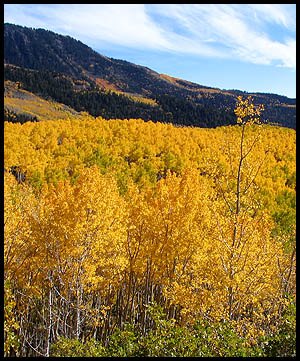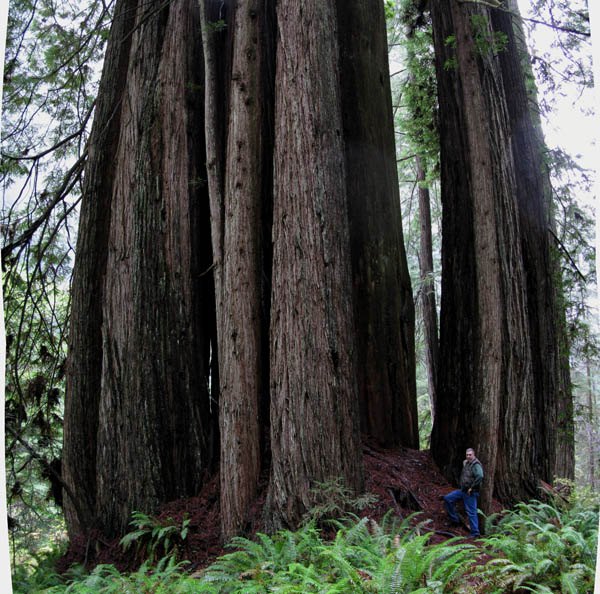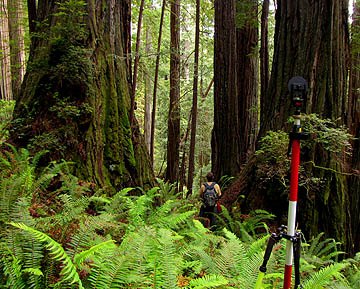
Giant Clonal Groves | Aspen vs. Redwood
Copyright 2010 by Mario Vaden
This page is in response to articles about the Pando Aspen Grove in Utah, said by some to be the largest clonal plant organism.

Image at right: Quaking Aspen, commonly spread by roots and sprouts.
In one article of many, Wikipedia opened with:
"Pando (or The Trembling Giant)[1] is a clonal colony of a single male Quaking Aspen (Populus tremuloides) located in the U.S. state of Utah, all determined to be part of a single living organism by identical genetic markers[2] and one massive underground root system, although whether it is a single tree is disputed, as it depends on one's definition of an individual tree. The plant is estimated to weigh collectively 6,000 tonnes ..."
That is an estimate of weight. Even the Pando grove age is an estimate. If the weight really was 6,000 tonnes, that would be 12,000,000 pounds (12 million pounds).
If you read about this Aspen grove, you may have read also that a group of giant redwoods (like 8 to 10 of them) could meet or beat the Pando grove for size or weight.
If the Pando aspen grove is really 12,000,000 lbs., then it would only take about 4 coast redwoods the size of Lost Monarch (near 3,000,000 lbs.) with shared roots and genetics to equal it. But few coast redwoods exist at that extreme weight even as individuals, let alone clonal groups.

advertisement
I don't consider a clonal grove of stems with a connected or shared root system to be a single tree. That a stretch to achieve a place in the record books when nothing else remains. But let us assume for a moment it's worth some attention.

Image above: is a "Fairy Ring" or "Cathedral" coast redwood in Prairie Creek, shown during 2008. I call this one The Titanic.
The Lindsey Creek redwood (6,000,000 lbs.) of the early 1900s would have only needed one other second trunk with adjoining roots. It was a single stem and has fallen. And presently, no coast redwood known would be over 3 million pounds.
The center stem of The Titanic coast redwood above broke off. Years ago, when the main trunk was intact, that main stem and the extra basal trunks probably weighed in the 3,000,000 pound range. I don't know if any surrounding redwoods are connected to it at the roots and genetically related. To match the Pando aspen for combined weight, it would probably need about 4, 5 or 6 other redwoods nearby to be connected to one another at the roots.
I have not looked. Its doubtful anybody else has looked. And I don't think anybody really cares to invest the time, testing and research.

In 2010, I was helping Chris Atkins to find and measure super tall coast redwoods related to LiDAR data, in Redwood National and State Parks. In one valley, I noticed an entire row of giant curly redwoods growing in a nearly perfect straight line. About a half dozen.
Image at right: Chris standing between two of many curly redwood giants growing up and down the hillside in a straight row. This was at the Brown Creek drainage uphill from the Brown Creek giant.
Curly redwood is not rare, but its far from common. Because the entire row were all in a straight line, they are most likely all the same genetically. A very tall redwood probably fell centuries ago, and these all sprouted from it. Examples of these variations can be seen in various parts of the redwood forest.
After finding these giant cathedral redwoods and such large rows genetically related (likely), I concluded that there is must be a good chance that some clonal grove of redwoods meets or exceeds the Pando aspen grove for weight and volume. But coast redwoods are notorious for sprouting and spreading from their root systems in some areas.
No such redwood groves have been published that I'm aware of in any way that would be thorough and exhaustive. But I heard an interview where a west coast researcher mentioned the existence of a couple. No location was offered, but I consider the person interviewed as a straight-shooter. Wish I had kept note of the video link. But for me, what matters is my own awareness.
FWIW ...here are my guesstimations about potential nature hunts:
Existence of clonal coast redwood as big as Pando Aspens 99%
Existence of Bigfoot in the 21st century 0%
Existence of a coast redwood larger than Lost Monarch 5%